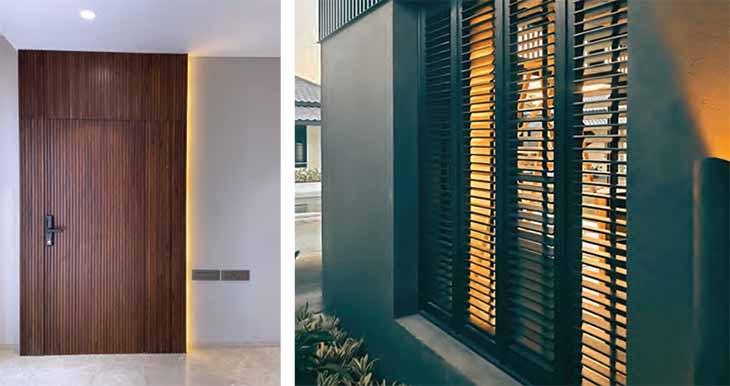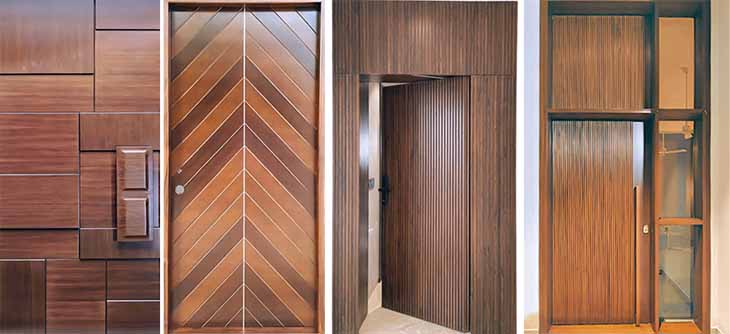Rites of passage: Craftsmanship complements tech in Indian door manufacturing

Kelveneers’ timber doors come in various forms: from pivot, sliding and slide-fold to French walk-through systems. With the correct hardware, they have sound-, dust-, wind- and rain-proof capabilities; and some come with fire-retardancy ratings.
Once considered mere functional entryways, doors in modern architecture have transformed into pivotal design elements, embodying style, precision, technology, and environmental responsibility. This evolution is particularly evident in India, where traditional craftsmanship is seamlessly merging with state-of-the-art manufacturing to redefine door-making techniques.
As material innovation and design expectations grow, the door manufacturing industry now stands at the exciting intersection of architecture, engineering, sustainability, and storytelling.
India’s rich woodworking heritage, from the robust teak facades of the South to the intricate carvings of Rajasthan, has long influenced door design. While this cultural legacy endures, the manufacturing process has undergone a significant modernisation.
Contemporary fabrication facilities now leverage kiln-dried wood, advanced CNC machining, and high-performance coatings to produce factory-finished doors. This ensures consistent quality and simplifies on-site installation, addressing both aesthetic demands and the inconsistencies often associated with traditional carpentry.

Main doors (L) are tailor-made to site requirements and made from solid wood and veneer. Louvered windows (R) provide a functional and aesthetic sunscreen system in homes.
Engineered for architecture
The success of a door no longer rests solely on a craftsman’s skill but equally on sophisticated engineering systems. Manufacturers are increasingly prioritising features such as sustainable cores, enhanced insulation properties, and high-performance hardware and coatings.
The phrase “engineered for architecture” encapsulates the current wave of door manufacturing, where advanced technological details are subtly integrated beneath aesthetically pleasing surfaces.
Homeowners today demand more than basic functionality; they seek thermal insulation, soundproofing, warp resistance, and ease of installation, all while maintaining a beautiful appearance.
High-performance door cores, precision CNC mortising, pre-slotted hinge placements, and plug-and-play installation methods significantly accelerate construction timelines and eliminate on-site guesswork.
Door frames are now routinely delivered with imported door seals, architraves, and factory-applied finishes. Furthermore, digital locks, multi-point locking systems, soft-close mechanisms, and concealed hinges are transitioning from luxury items to standard specifications, enhancing usability, security, and long-term durability.
Sustainable material
With growing environmental consciousness across industries, door manufacturers are re-evaluating their material sourcing and production processes. A notable shift is the increased adoption of plantation-grown timber, a crucial step in combating deforestation.
Simultaneously, the industry is embracing engineered solutions like tubular core construction. This innovation drastically reduces the volume of solid timber required per door, resulting in products that are structurally stable, acoustically sound, and lighter in weight – which in turn lowers transportation and handling emissions.
The transition from traditional site-based carpentry to controlled factory environments also facilitates greater material optimization. Zero-waste practices are becoming common, with wood shavings, offcuts, and leftover materials being repurposed for handicrafts or low-emission energy production.
Indian door design trends are no longer confined by geographical boundaries. Aesthetics from around the world – including Japanese minimalism, tropical openness, and Mediterranean warmth – are influencing Indian designers and manufacturers.
There’s a noticeable rise in demand for doors exceeding 10 feet in height, veneered doors with intricate grooved detailing, and solid wood doors featuring bespoke finishes, all tailored to complement modern Indian interiors.

Interior doors can come with 3-D embellishments, grooves and geometric patterns, various colours and wood species, and often with customised inlays.
Modular integration
These design choices go beyond mere decoration; they reflect how homeowners perceive doors as integral expressions of their identity and architectural vision. Such doors are frequently found in contemporary homes, bungalows and heritage renovations.
The future of door manufacturing in India points towards increased modular integration, rapid on-site execution, and a deeper fusion of technology and aesthetics. While the human touch remains vital, the role of design intelligence, sustainable practices, and machine-assisted precision is continuously expanding.
As homeowners, architects, and designers increasingly seek meaning in materiality, doors will evolve from mere passages to integral components that add soul and character to the architecture.
– The writer is Design Director of Bengaluru-based Kelveneers and Aristo-India, with over 22 years of experience in woodworking, modular kitchens, custom cabinetry, veneers and timber doors. He is an industrial engineer from one of India’s leading schools. You may follow him on Instagram/ Facebook @kelveneers.
Comments

- European symposium highlights formaldehyde emission limits
- Egger adopts holistic approach to waste management
- ‘For customers, our lab is an open book’
- Taiwan’s Woodworking Machinery Industry Captivates Global Media on Opening Day of LIGNA 2025
- Coming of age of sustainability
- Intelligent packing line, sander from Woodtech
- Ornare introduces 5 new leather decors
- Richfill Edge Coat offers safer plywood finishing
- Jai’s Optimus range stays ahead of the curve
- Merino’s Acrolam sets new benchmarks in elegance
- Pytha 3D-CAD: where precision meets production
- Raucarp edge bands: simple, affordable
- Greenlam scores a 1st: High Quality Product Award
- Häfele turns space solutions provider
- Hettich bets on intelligent motion for evolving interiors
- Praveedh taking desi innovation to the global stage
- Turakhia shows off its Natural Veneers range
- Egger continues to ‘inspire, create, grow’
- Blum turns heads with new drawer, hinge systems
- Murubi gives American ash a meaningful life
- AR system makes ‘augmented carpentry’ possible
- Felder converts interior firm’s vision to reality
- Smart manufacturing with ‘intelligent’ tools
- Rites of passage: Craftsmanship complements tech in Indian door manufacturing
- Understanding basics of adhesives and sealants
- FFSC looks back at a decade of purpose
- Industrial-grade tools for modern manufacturing
- AWM ties up with Yeutong to boost production
- KolkataWood opens 12-14 September
- AI transforming wood panel manufacturing
- Interzum Jakarta promises a bonanza
- Expert partner in product, factory planning
- CBD Guangzhou 2025 grew 47%
- SCM hosts ‘Timber Construction Days’
- Events Calendar: Industry Fairs you must visit
- Bio-designed ‘leather’ from scrap tyres?
- HiTorc chipper redefines wood processing
- Cooking ‘veggies’ for protein-based adhesives
- Hafele’s digital locks go smart
- Italy’s Essepigi has special door lines
- Mirka is a revolution in sanding, finishing
- Ozone expands range of door hardware
- Adhesives: best practices, applications, choices
- Weber sanding tech stands up to Swiss precision
- Silent heroes in homes: Blum fittings
- Biesse powers ahead with smarter, greener manufacturing
- Homag’s LCS program ensures smooth operation
- Paged Furniture reclaims the past, shapes the future



































